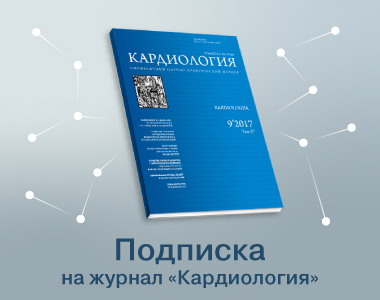Model of Two‐Years Forecasting of the Anti‐Existent Patients With Acute Decompensation of Heart Failure on the Background of the Intermediate Fraction of Left Ventricle
https://doi.org/10.18087/cardio.2020.1.2673
Abstract
Objective. Build a prognostic model using clinical, laboratory, and instrumental data to predict mortality in patients with midrange left ventricular ejection fraction (mrLVEF) within two years after hospitalization for acute decompensated heart failure (ADHF).
Materials and Methods.The study included 121 patients hospitalized for ADHF with mrLVEF ranging from 40% to 49.9% (91 males and 30 females, mean age 64.6±14.8 years). The independent sample used to validate the statistical model included 71 patients with ADHF and mrLVEF with a mean age of 65.59±12.12 years. Sex distribution of the independent sample was 51 males (70.8% of the independent sample), 20 females (27.8% of the total independent sample). In-hospital mortality of patients included in the study was 4.2%, and long-term mortality was 36.8%. We developed a tool to assess the risk of two-year mortality using classification trees.
Results.The root node is the red blood cell distribution width–coefficient of variation (RDW-CV); its diagnostic value in this model was 13.3%. The second-level nodes are glomerular filtration rate (GFR), with a cutoff level of 35 mL/min/1.73 m2, and chronic kidney disease (CKD). The third-level nodes are sex, the anterior-posterior dimension of the left atrium, with the cutoff level >47 mm, and low red blood cell count <4.22x1012/L. The estimated sensitivity of the model is 71.4%; estimated specificity is 85.7%.
Conclusion.This model can be used to assess long-term mortality risk and identify groups of patients with mrLVEF who require closer monitoring.
About the Authors
E. G. SkorodumovaRussian Federation
St. Petersburg
V. A. Kostenko
Russian Federation
St. Petersburg
E. A. Skorodumova
Russian Federation
St. Petersburg
A. V. Siverina
Russian Federation
St. Petersburg
K. S. Shulenin
Russian Federation
St. Petersburg
A. V. Rysev
Russian Federation
St. Petersburg
References
1. Lam CSP, Solomon SD. The middle child in heart failure: heart failure with mid-range ejection fraction (40-50%). European Journal of Heart Failure. 2014;16(10):1049–55. DOI: 10.1002/ejhf.159
2. Kostenko V.A., Sitnikova M.Yu., Skorodumova E.A., Fedorov A.N., Skorodumova E.G. New Scale for Assessment of Prognosis of Survival for Two Years After Hospitalization Because of Acute Decompensation of Heart Failure. Kardiologiia. 2017;57(6):33–9. [Russian]
3. Skorodumova E.G., Kostenko V.A., Skorodumova E.A., Rysev A.V. Problems and specificity of diagnostics of acute heart failure in patients with intermediate ejection fraction at the ноspital stage. Emergency Medical Care. 2018;19(1):16–9. [Russian]
4. Ponikowski P, Voors AA, Anker SD, Bueno H, Cleland JGF, Coats AJS et al. 2016 ESC Guidelines for the diagnosis and treatment of acute and chronic heart failure: The Task Force for the diagnosis and treatment of acute and chronic heart failure of the European Society of Cardiology (ESC) Developed with the special contribution of the Heart Failure Association (HFA) of the ESC. European Heart Journal. 2016;37(27):2129–200. DOI: 10.1093/eurheartj/ehw128
5. Komajda M, Lam CSP. Heart failure with preserved ejection fraction: a clinical dilemma. European Heart Journal. 2014;35(16):1022–32. DOI: 10.1093/eurheartj/ehu067
6. Kociol RD, Hammill BG, Fonarow GC, Klaskala W, Mills RM, Hernandez AF et al. Generalizability and longitudinal outcomes of a national heart failure clinical registry: Comparison of Acute Decompensated Heart Failure National Registry (ADHERE) and non-ADHERE Medicare beneficiaries. American Heart Journal. 2010;160(5):885– 92. DOI: 10.1016/j.ahj.2010.07.020
7. Hülsmann M, Berger R, Mörtl D, Pacher R. Influence of age and in-patient care on prescription rate and long-term outcome in chronic heart failure: a data-based substudy of the EuroHeart Failure Survey. European Journal of Heart Failure. 2005;7(4):657–61. DOI: 10.1016/j.ejheart.2004.11.011
8. Martinsson A, Oest P, Wiborg M-B, Reitan Ö, Smith JG. Longitudinal evaluation of ventricular ejection fraction and NT-proBNP across heart failure subgroups. Scandinavian Cardiovascular Journal. 2018;52(4):205–10. DOI: 10.1080/14017431.2018.1461920
9. Karabağ Y, Çınar T, Çağdaş M, Rencüzoğulları İ, Tanık VO. In-hospital and long-term prognoses of patients with a mid-range ejection fraction after an ST-segment myocardial infarction. Acta Cardiologica. 2019;74(4):351–8. DOI: 10.1080/00015385.2018.1501140
10. Lauritsen J, Gustafsson F, Abdulla J. Characteristics and long-term prognosis of patients with heart failure and mid-range ejection fraction compared with reduced and preserved ejection fraction: a systematic review and meta-analysis. ESC Heart Failure. 2018;5(4):685–94. DOI: 10.1002/ehf2.12283
11. Mavrea A, Korpos-Gyalai I, Citu I, Ancusa O, Bordejevic A, Tomescu MC. Long-term prognosis and modes of death in heart failure patients with reduced versus preserved left ventricular systolic function. European Scientific Journal. 2013;3:246–53. [Av. at: https://eujournal.org/index.php/esj/article/view/2431/2304]
12. Zafrir B, Lund LH, Laroche C, Ruschitzka F, Crespo-Leiro MG, Coats AJS et al. Prognostic implications of atrial fibrillation in heart failure with reduced, mid-range, and preserved ejection fraction: a report from 14 964 patients in the European Society of Cardiology Heart Failure Long-Term Registry. European Heart Journal. 2018;39(48):4277– 84. DOI: 10.1093/eurheartj/ehy626
13. Leng S, Tan R-S, Zhao X, Allen JC, Koh AS, Zhong L. Validation of a rapid semi-automated method to assess left atrial longitudinal phasic strains on cine cardiovascular magnetic resonance imaging. Journal of Cardiovascular Magnetic Resonance. 2018;20(1):71–6. DOI: 10.1186/s12968-018-0496-1
14. Mozaffarian D, Anker SD, Anand I, Linker DT, Sullivan MD, Cleland JGF et al. Prediction of mode of death in heart failure: the Seattle Heart Failure Model. Circulation. 2007;116(4):392–8. DOI: 10.1161/CIRCULATIONAHA.106.687103
15. Shlyakhto E.V., Sitnikova M.Yu., Lelyavina T.A., Ivanov S.G., Fedotov P.A. et al. Current algorithms for evaluation of prognosis in patients with CHF. Comparative characteristics of BNP – age‐related modEl of SurVivAl (NEVA‐75) and Seattle Heart Failure Model in patients aged 75–85 years. Russian Heart Failure Journal. 2009;10(1):4–7. [Russian]
Review
For citations:
Skorodumova E.G., Kostenko V.A., Skorodumova E.A., Siverina A.V., Shulenin K.S., Rysev A.V. Model of Two‐Years Forecasting of the Anti‐Existent Patients With Acute Decompensation of Heart Failure on the Background of the Intermediate Fraction of Left Ventricle. Kardiologiia. 2020;60(1):23-27. https://doi.org/10.18087/cardio.2020.1.2673
















